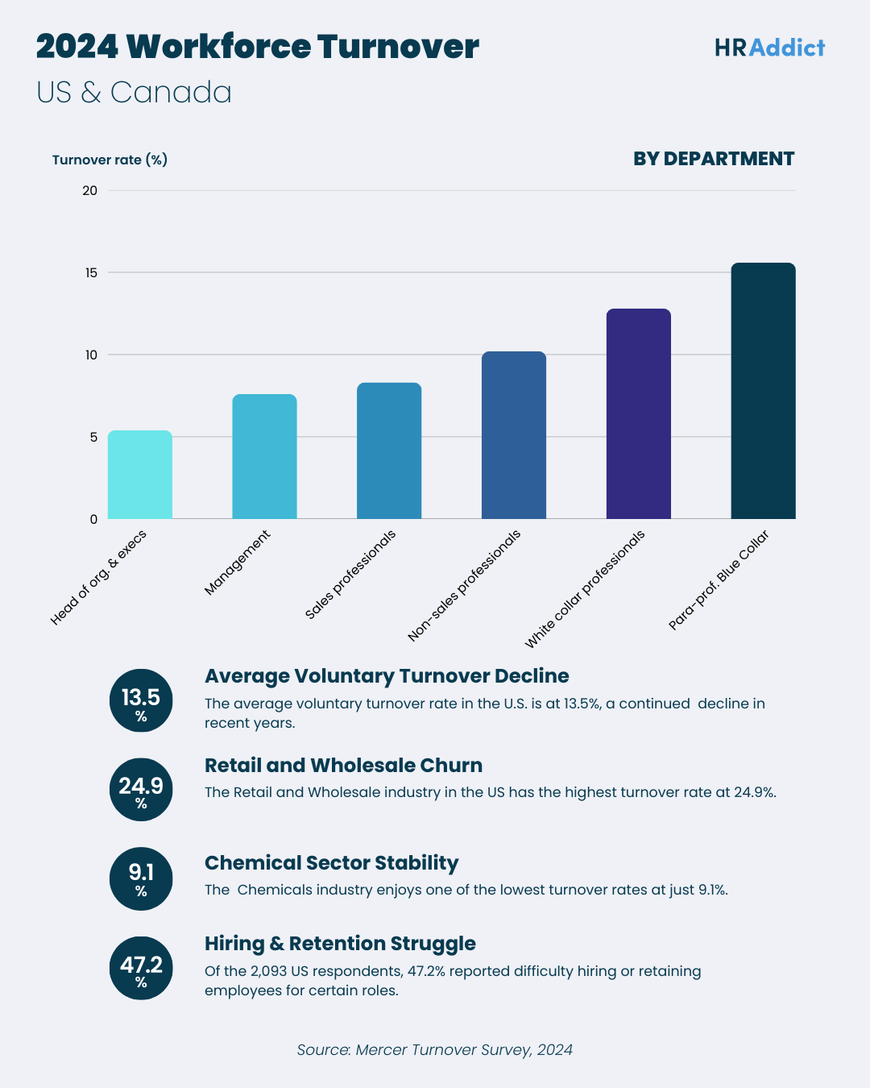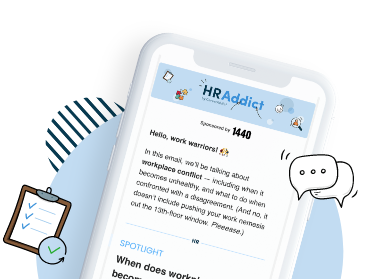Employee retention is a vital health check for organizations. A practice typically associated with human resources management, managers must also be involved in the art of retaining employees.
Effective employee retention offers plenty of benefits for organizations, and there are lots of ways to go about doing this. This article covers all that you need to know about how to retain employees, including why it’s important, factors that influence retention, and some useful tips on how to do so.
What is employee retention?
Employee retention refers to an organization’s ability to keep its employees over a period of time. It is a measure of how successful a company is at maintaining a stable workforce by reducing staff turnover and keeping valuable talent within the organization.
Companies often have “retention factors” shown as a percentage, which is typically calculated by taking the total number of employees, subtracting the number who have left, and dividing this number by the total number of employees again.
For example, in an organization of 300 people with 40 leavers:
300 - 40 = 240
240 ÷ 300 = 0.8 (or a retention rate of 80%)
Employee retention strategies and initiatives are put in place to create a work environment where employees are motivated, satisfied and committed to their jobs and the company, thereby reducing the likelihood that they will seek employment opportunities elsewhere. High employee retention is often seen as a positive indicator of an organization’s overall health and can lead to lots of benefits for employees and the company itself.
Here is an infographic we created of key workforce turnover rates based on Mercer findings:

Why employee retention is important
Employee retention is way more than a simple HR measure. It impacts many areas of organizational performance, the key elements of which are detailed below:
- Decreased costs: High turnover can be expensive. Recruiting, onboarding and training new employees can cost a significant amount of time and resources. Retaining staff reduces these costs.
- Employee satisfaction: Employee retention is often a reflection of employee satisfaction. High turnover rates can be a sign of underlying issues within the organization, which need to be addressed to maintain a satisfied workforce.
- Knowledge and expertise: Long-tenured employees often possess valuable institutional knowledge and expertise. Their departure can result in the loss of this knowledge, which can be challenging to replace.
- Productivity and efficiency: Experienced employees tend to be more productive and efficient in their roles. High turnover disrupts workflow and can lead to decreased productivity as new hires get up to speed.
- Team cohesion: Frequent turnover can disrupt team dynamics and cohesion. When employees stay, they build stronger working relationships and better collaboration, contributing to a more harmonious work environment.
Factors that influence employee retention
In order to understand how best to retain employees, it’s important to learn about the factors that influence employee retention. Here are the main areas that drive this important measurement:
Career development opportunities
Opportunities for career advancement and growth within the organization are vital for retaining employees. When employees see a clear path for professional development, they are more likely to commit to their current employer rather than seek opportunities elsewhere.
Compensation and benefits
Competitive and fair compensation is a critical factor in retention. Employees who believe they’re being compensated appropriately for their skills and contributions are less likely to leave. Additionally, comprehensive benefits packages, including healthcare, retirement plans and bonuses, can enhance retention.
Management and leadership
Supervisors and managers play a pivotal role in employee retention. Effective leadership that provides guidance, support, feedback, motivation and recognition fosters a positive relationship between employees and their managers. Employees are more likely to stay in roles where they have a strong rapport with their supervisors.
Onboarding and training
Effective onboarding is critical for retention as the employee’s first few weeks in your company will set the tone for everything that’s to come. Land the employee well and ensure they’re settled with a buddy and training opportunities, and they’ll be more inclined to stay. Learning interventions should remain long after the employee has onboarded — ongoing formal and informal learning opportunities are a great way to drive loyalty.
Workplace culture and environment
A positive workplace culture and a supportive work environment are key drivers of employee retention, as employees are more likely to stay in organizations where they feel respected and appreciated. A culture that promotes inclusivity, values diversity and provides a sense of belonging can significantly improve retention rates. Organizations can also achieve this through respecting work–life balance and flexible working.
How to retain employees
We have already discussed how employee retention can impact many areas of the organization. Staff retention is also influenced by factors which make up a large part of the employee experience. So, what can we do to retain employees? This section covers the 10 most effective and impactful hacks for how to improve retention:
1. Live up to the company’s mission and values
Reinforce the organization’s mission and values in everyday operations. This begins with organizational leadership, ensuring that your senior stakeholders are living and breathing the culture. This will increase the likelihood of inspiring employees to do the same.
It’s vital to support employees in understanding how their work connects to a larger purpose, as this will help them recognize that what they do is important in helping to drive the company forward.
2. Develop effective recruitment practices
Start the retention process during recruitment process by selecting the best employees who align with the organization’s culture and values. Subsequent retention interventions will be a lot simpler if all employees are singing off the same sheet.
Use behavioral interviewing techniques and cultural fit assessments to attract good employees who are likely to thrive within the company. This will ensure that incoming employees resonate with your organizational values, as well as establish consistent and fair processes that will promote the company as a great place to work. Take time to regularly analyze your internal talent, and ensure that all open roles are marketed to existing employees as a priority.
3. Establish an effective employee engagement process
Measure and monitor employee engagement through surveys and feedback mechanisms. Establish structured and consistent processes for measuring employee engagement, and focus on the questions you want to ask as well as the goals you want to achieve.
Surveying employees is only the start. Employers must act on the engagement survey results to address areas of concern and strengthen employee engagement. Involve employees in decision-making processes, when possible, as this will help them feel that they’re part of the strategies as well as empower them along the way. Promote what has been achieved as part of the preparation for the next engagement survey.
4. Empower employees
Feeling valued and influential can boost job satisfaction and retention. Empower employees by involving them in decision-making processes, allowing them to contribute ideas, and giving them ownership over their work.
Empowerment needs to be executed in the right way for it to be effective. Develop your employees’ knowledge for starters. Encourage them to become confident in using their new skills, and give them the space to do so. Support them in turning this confidence into experience by thoughtfully delegating and establishing parameters. Finally, reward employees in becoming successfully empowered by beginning this cycle once more!
5. Focus on your recognition programs
Non-financial benefits, ones without money focuses, are just as important for retention as salary and bonuses. Employees are increasingly looking for meaningful and extensive recognition programs that are aligned with their own needs. These might include regular and sincere organizational recognition, as well as a suite of company benefits.
Wellbeing interventions make up a large part of these recognition programs, especially today in 2024. Offering your employees services such as gym discounts, mental health support and flexible working opportunities are fantastic ways to drive a positive and inclusive company culture, which in turn drives retention.
6. Implement team-building activities
Teambuilding activities are more than just a “jolly” away from the workplace. They can be meaningful and reasonably cost-effective ways to develop teams while encouraging socialization, both of which are important aspects of employee retention.
As long as they are inclusive, team-building activities can be work-focused, such as training or knowledge-based interventions. Non-work-related examples could be a team meal, a few games of bowling or drinks after work.
Establishing a budget and allocating time during the working week for these activities can ensure that regular team-building activities become a ritual that has a lasting impact on employee retention.
7. Conduct regular performance reviews
Performance reviews might not be the most enjoyable aspect of work, but they are a powerful retention tool.
Performance reviews serve two main purposes. Firstly, they provide employees with a chance to receive (and provide) detailed, structured feedback. Employees might also value some quality one-on-one time with their manager.
Secondly, performance reviews focus on personal and professional goals. Driving employee motivation through challenging targets and personal development can be a powerful way to foster loyalty. Consider setting up a structured performance review and goal-setting process for maximum impact, such as mid-year and end-of-year reviews.
8. Promote a culture of learning
It’s human nature to want to continuously learn more and if organizations get this right, then high employee retention will follow. Encourage a culture of continuous learning within your company by emphasizing the value of acquiring new skills and knowledge to remain competitive in the industry.
Invest in training and development opportunities, and analyze which ones will closely align with employees’ career goals and aspirations, as this will have the best impact. Finally, provide ongoing learning resources and encourage skills enhancement, as well as driving coaching and mentoring opportunities at all levels of the organization.
9. Promote inclusivity and diversity
If people feel valued and respected in your company, as well as feel that they contribute to that sense of belonging, they’re more likely to want to remain working there.
Embrace inclusivity and diversity within your organization by ensuring that all employees, regardless their background, feel welcome, respected and represented.
Additionally, promote diversity in hiring and leadership. This not only ensures that you are embracing diversity, equality and inclusion, but it will also ensure that organizational teams are composed of a wide variety of personalities and outlooks, which is a great way to foster collaboration and creative ways of working; yet more reasons for employees to remain loyal!
10. Provide competitive pay
Ensure that your employees are fairly compensated for their skills and contributions. Regularly review and adjust salaries to match industry standards. Additionally, offer competitive benefits packages, including healthcare, retirement plans and other perks that align with employee needs and expectations.
You can also recognize employees by providing competitive bonus programs and providing other effective benefits like enhanced pension schemes and comprehensive private healthcare.
Tips for retaining employees
Alongside the above techniques for retaining employees, there are also some good tips to bear in mind as you go about your retention journey. These tips can be used concurrently with the above techniques for maximum impact:
- Ask for employee feedback. Continuously gather employee feedback through surveys, suggestion boxes or feedback channels. Use this feedback to make real-time improvements and demonstrate that you value your employees’ opinions.
- Be fair and consistent in all that you do. Whether it’s implementing training or redesigning compensation and benefit programs, ensure that your organization operates consistently. Employees are unlikely to want to remain working somewhere that treats individuals differently.
- Create a culture of openness and trust. Trust is a vital component for retaining employees. Trust employees to work and give them the space to do so, as well as enable them to communicate freely, respectfully and honestly.
- Communicate transparently. Maintain transparent communication channels to keep employees informed about company developments, changes and goals. This ensures employees hear information first-hand and reduces the likelihood of damaging rumors and gossip.
- Use emotional intelligence. As a leader, keep your ear to the ground and listen to your employees. Get to know them and empathize with them, and you’ll start to understand when things aren’t right and act accordingly.
Key takeaways
Employee retention has a significant organizational impact, and leaders are empowered to drive it forward and ensure that employees are looked after to foster loyalty.
Here are the key elements of employee retention:
- Employee retention is a critical aspect of organizational success.
- It impacts many areas of organizational performance, and a low retention percentage can lead to numerous challenges.
- It is influenced by many intertwined factors that can be controlled and monitored.
- Focus on employee retention programs as a key leadership trait. Ensuring consistency, and emphasizing empathy with your employees, should be a top priority.
Regarding employee retention as a fundamental organizational measure and not just an HR statistic is essential to drive business performance. Increasing this metric will set your company up for plenty of future success.
Got a question? Let us know in the comments section below.
This article was originally published back in 2017.

